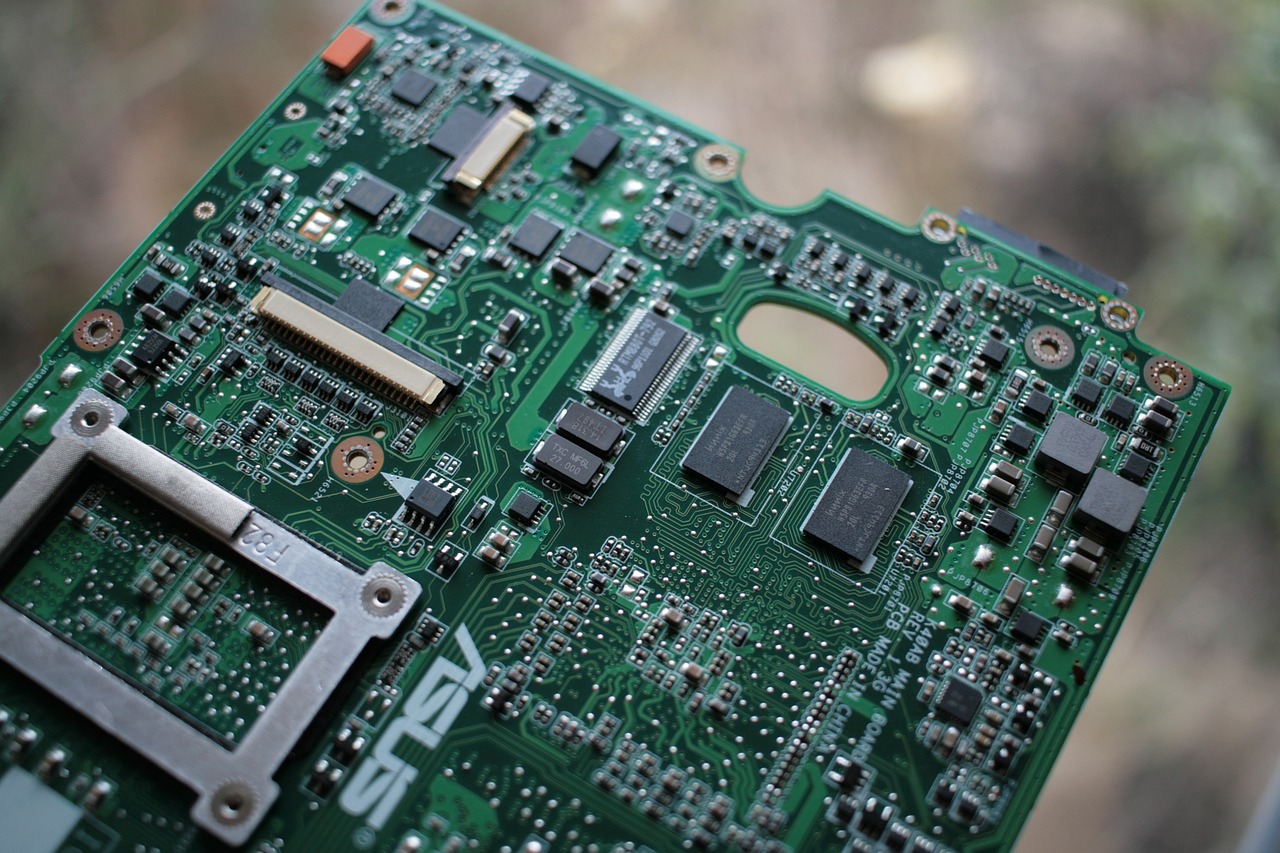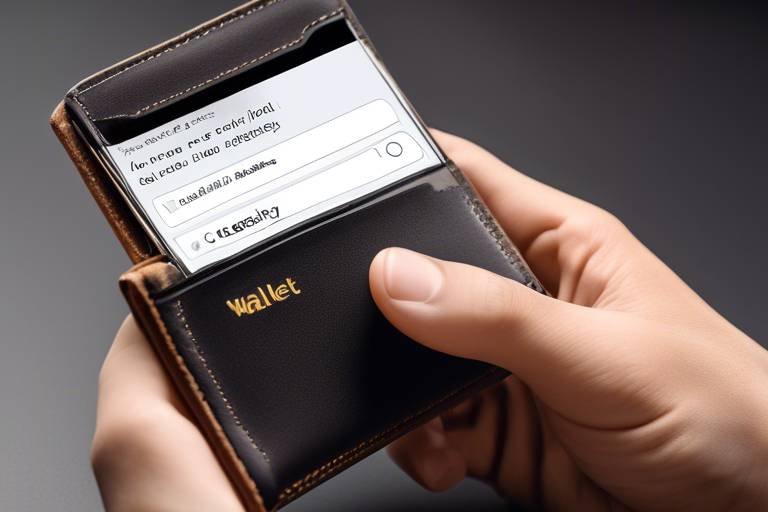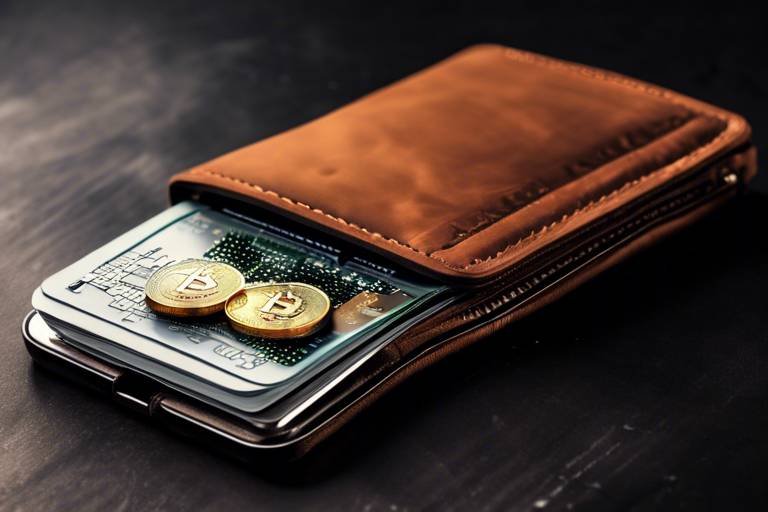Understanding the Security Challenges of Cross-Chain Wallets
In the ever-evolving world of cryptocurrency, cross-chain wallets have emerged as a revolutionary tool, allowing users to manage multiple cryptocurrencies across different blockchain networks. But with innovation comes a host of security challenges that can leave users vulnerable. As we navigate this digital landscape, it's crucial to understand the potential risks associated with cross-chain wallets and how to safeguard against them. Are you prepared to dive into the complexities of securing your digital assets?
Cross-chain wallets serve a vital purpose; they enable seamless transactions between various cryptocurrencies, eliminating the need for multiple wallets. Imagine being able to manage Bitcoin, Ethereum, and other altcoins all in one place! However, this convenience can also attract malicious actors who are constantly on the lookout for vulnerabilities to exploit. For instance, if a wallet has a flaw in its smart contract or if a user falls victim to a phishing attack, the consequences can be dire, leading to significant financial losses.
The landscape of blockchain technology is constantly evolving, and so are the strategies employed by cybercriminals. This article will explore the various security challenges associated with cross-chain wallets, providing insights into vulnerabilities, best practices, and the measures that can be taken to enhance user protection and trust. By the end of this discussion, you will be better equipped to navigate the complexities of cross-chain wallets and protect your digital assets.
Cross-chain wallets are designed to facilitate transactions across various blockchain networks, allowing users to manage multiple cryptocurrencies seamlessly. Unlike traditional wallets that are limited to a single blockchain, cross-chain wallets leverage advanced technologies to enable interoperability. This means that users can send and receive different cryptocurrencies without the hassle of converting them through centralized exchanges.
But how do these wallets work? At their core, cross-chain wallets utilize smart contracts and atomic swaps to execute transactions. Smart contracts are self-executing contracts with the terms of the agreement directly written into code, while atomic swaps allow for the exchange of one cryptocurrency for another without the need for an intermediary. This innovative approach not only enhances user experience but also introduces new security challenges that must be addressed.
As promising as cross-chain wallets may be, they are not without their vulnerabilities. Users must be aware of the potential risks that come with managing multiple cryptocurrencies in one place. Some of the most common security vulnerabilities include:
- Smart Contract Flaws: Bugs or vulnerabilities in smart contracts can be exploited, leading to unauthorized access and loss of funds.
- Phishing Attacks: Cybercriminals often use social engineering tactics to trick users into revealing sensitive information.
- Improper Key Management: Failing to securely manage private keys can result in unauthorized access to a user's wallet.
Understanding these vulnerabilities is the first step in safeguarding your assets. In the following sections, we will delve deeper into each of these challenges, providing practical solutions and best practices for users.
Smart contracts are a double-edged sword in the realm of cross-chain wallets. While they offer a level of automation and security, they are also susceptible to bugs and vulnerabilities. For instance, if a smart contract is poorly coded, it could allow attackers to exploit these weaknesses, gaining unauthorized access to users' funds. It's essential to recognize that the security of a cross-chain wallet is only as strong as its underlying smart contracts.
To mitigate the risks associated with smart contracts, rigorous code audits and testing are imperative. Developers should conduct thorough audits to identify potential vulnerabilities before deployment. This process involves examining the code for bugs, conducting stress tests, and ensuring that the contract behaves as intended under various conditions. By investing in comprehensive testing, developers can significantly reduce the likelihood of exploits.
There have been several notable real-world exploits targeting cross-chain wallets, each serving as a cautionary tale for users. For instance, in 2021, a vulnerability in a popular cross-chain wallet led to the loss of millions of dollars in user funds. These incidents highlight the importance of vigilance and the need for users to remain informed about the security of their wallets.
Phishing attacks and social engineering tactics are prevalent threats faced by cross-chain wallet users. Attackers often pose as legitimate entities, tricking users into providing sensitive information like private keys or passwords. These tactics can be incredibly convincing, making it essential for users to remain vigilant and skeptical of unsolicited communications.
To enhance the security of your cross-chain wallet, there are several best practices you should follow. These include:
- Using Hardware Wallets: Hardware wallets provide an added layer of security by storing your private keys offline.
- Strong Passwords: Always use complex and unique passwords for your wallet accounts.
- Two-Factor Authentication: Enable 2FA to add an extra layer of protection to your wallet.
By implementing these practices, you can significantly reduce the risk of unauthorized access to your digital assets.
User education plays a pivotal role in enhancing the security of cross-chain wallets. By understanding the threats and recognizing the signs of phishing attempts, users can make informed decisions regarding their wallet usage. It's essential to stay informed about the latest security trends and to participate in community discussions about best practices.
The landscape of cybersecurity is ever-changing, and new threats emerge regularly. Therefore, staying updated on emerging threats and security updates is crucial for users. Regularly monitoring wallet security and engaging with community forums can help users remain informed and prepared for potential risks.
As we look to the future, the security landscape for cross-chain wallets is likely to evolve alongside technological advancements and regulatory measures. Innovations in blockchain technology, such as improved encryption methods and decentralized identity solutions, could enhance user protection and trust in the ecosystem. By embracing these advancements, users can feel more secure in their digital transactions.
Q: What is a cross-chain wallet?
A: A cross-chain wallet allows users to manage multiple cryptocurrencies across different blockchain networks seamlessly.
Q: What are the main security risks associated with cross-chain wallets?
A: Common risks include smart contract flaws, phishing attacks, and improper key management.
Q: How can I protect my cross-chain wallet?
A: Use hardware wallets, enable two-factor authentication, and educate yourself about potential threats.
Q: Why are smart contracts important for cross-chain wallets?
A: Smart contracts automate transactions and facilitate exchanges between different cryptocurrencies, but they also introduce security risks if not properly audited.

The Basics of Cross-Chain Wallets
Cross-chain wallets are a remarkable innovation in the realm of cryptocurrency, allowing users to manage multiple digital assets across various blockchain networks seamlessly. Imagine trying to juggle different currencies from various countries; it can get quite messy! Now, picture a wallet that can handle all these currencies effortlessly—this is exactly what cross-chain wallets do for cryptocurrencies. They facilitate transactions between different blockchains, enabling users to send, receive, and store a diverse range of cryptocurrencies without the hassle of switching platforms.
The primary purpose of cross-chain wallets is to enhance user experience by providing a unified interface for managing assets. Instead of relying on multiple wallets for different cryptocurrencies, users can leverage a single cross-chain wallet to access various blockchain ecosystems. This not only simplifies the management of digital assets but also promotes greater liquidity and flexibility. With the rise of decentralized finance (DeFi) and the growing popularity of various blockchain networks, cross-chain wallets have become essential tools for crypto enthusiasts.
At their core, cross-chain wallets utilize advanced technology to communicate between different blockchains. They employ protocols that allow for the transfer of information and assets across these networks. For instance, when a user wants to exchange Bitcoin for Ethereum, the cross-chain wallet facilitates this transaction by interacting with both the Bitcoin and Ethereum blockchains, ensuring that the process is smooth and secure. This capability is crucial in a world where different cryptocurrencies serve various purposes and are built on distinct platforms.
However, while the functionality of cross-chain wallets is impressive, it’s essential to understand that they also come with their own set of challenges and vulnerabilities. The complexity of handling multiple blockchains can introduce risks, especially if the underlying technology is not robust. Users must remain vigilant and informed about the potential threats that can compromise their assets. This is where the importance of security measures and best practices comes into play.
In summary, cross-chain wallets represent a significant leap in cryptocurrency management, offering users the ability to handle multiple assets from different blockchains in one place. They simplify transactions, enhance liquidity, and provide a user-friendly experience. However, as with any technological advancement, it’s crucial for users to be aware of the associated security challenges and to take proactive steps to protect their investments.
- What is a cross-chain wallet? A cross-chain wallet is a digital wallet that allows users to manage and transact multiple cryptocurrencies across different blockchain networks.
- How do cross-chain wallets work? They utilize protocols that enable communication between different blockchains, facilitating seamless transactions and exchanges of assets.
- Are cross-chain wallets secure? While they offer convenience, users must be aware of potential vulnerabilities and implement best practices to enhance security.
- What are the benefits of using a cross-chain wallet? Benefits include simplified asset management, enhanced liquidity, and the ability to interact with various blockchain ecosystems in one place.

Common Security Vulnerabilities
When diving into the world of cross-chain wallets, it's crucial to understand the myriad of security vulnerabilities that can jeopardize your assets. These wallets, designed to facilitate transactions across various blockchain networks, are not impervious to threats. In fact, their complexity can sometimes be a double-edged sword, making them attractive targets for malicious actors. Let's explore some of the most prevalent security vulnerabilities that users should be aware of.
One of the most significant risks comes from smart contract flaws. Smart contracts are automated agreements that execute when certain conditions are met, but if there's a bug in the code, it can lead to catastrophic failures. For instance, an attacker could exploit a vulnerability to gain unauthorized access to funds, leading to significant financial losses. This is why understanding the underlying code of a smart contract is essential. It's not just about trusting the wallet; it's about trusting the technology that powers it.
Smart contracts, while revolutionary, are not without their pitfalls. The risks associated with them are compounded by the fact that once deployed, they cannot be changed easily. This permanence means that any flaws can be exploited indefinitely until a solution is found. Imagine a house built on a shaky foundation; no matter how beautiful the house is, it remains at risk of collapse. Similarly, a poorly coded smart contract can lead to a wallet's downfall.
To mitigate these risks, rigorous code audits and testing are paramount. Before deploying a smart contract, developers should conduct thorough reviews to identify and fix potential vulnerabilities. This process is akin to a safety inspection for a vehicle; without it, you might find yourself stranded on the road of blockchain innovation. Engaging third-party auditors can also provide an unbiased perspective, ensuring that the contract is secure from various angles.
Real-world exploits serve as stark reminders of the vulnerabilities present in cross-chain wallets. For instance, there have been incidents where attackers successfully compromised wallets by exploiting smart contract flaws, leading to millions of dollars in losses. Each of these cases provides valuable lessons; they highlight the importance of continuous improvement in security measures. As we learn from these incidents, the blockchain community can adapt and evolve to create safer environments for users.
Another common vulnerability lies in phishing attacks and social engineering tactics. Attackers often use deceptive emails or websites to trick users into providing their private keys or recovery phrases. It's akin to leaving your front door unlocked because you trust your neighborhood; one day, you might find your valuables missing. Users must remain vigilant and educate themselves about these tactics to protect their assets. Always double-check URLs and be cautious of unsolicited communications requesting sensitive information.
Lastly, improper key management can lead to devastating consequences. Users often underestimate the importance of securely storing their private keys. If someone gains access to these keys, they have full control over the wallet's assets. It's like giving someone the keys to your safe without a second thought; the potential for loss is enormous. Therefore, utilizing hardware wallets and employing strong passwords can significantly enhance security.
In summary, while cross-chain wallets offer incredible flexibility and convenience, they also come with inherent risks. By understanding these vulnerabilities—smart contract flaws, phishing attacks, and improper key management—users can take proactive steps to safeguard their assets. The key is to stay informed and always prioritize security in your cryptocurrency dealings.
- What is a cross-chain wallet? A cross-chain wallet allows users to manage multiple cryptocurrencies across different blockchain networks, facilitating seamless transactions.
- How can I protect my cross-chain wallet? Use strong passwords, enable two-factor authentication, and consider using hardware wallets to enhance security.
- What are smart contract flaws? Smart contract flaws are vulnerabilities in the code that can be exploited by attackers, potentially leading to unauthorized access to funds.
- How can I identify phishing attempts? Always verify the URL of websites and be cautious of unsolicited messages requesting sensitive information.

Smart Contract Risks
When we talk about cross-chain wallets, one of the most pressing concerns that arise is the inherent risks associated with smart contracts. These contracts are essentially self-executing agreements with the terms of the agreement directly written into code. While they offer a revolutionary way to facilitate transactions without intermediaries, they are not without their vulnerabilities. Imagine a house built on a shaky foundation; no matter how beautiful the structure is, it remains at risk of collapse. Similarly, if the code behind a smart contract has flaws, it can lead to devastating consequences, including unauthorized access and the potential loss of funds.
One of the primary risks stems from bugs in the code. Just like a typo in a recipe can ruin a dish, a small error in the smart contract code can be exploited by malicious actors. These bugs can allow attackers to manipulate the contract’s logic to their advantage, leading to significant financial losses for unsuspecting users. Furthermore, the complexity of these contracts often makes it difficult for even seasoned developers to spot potential issues before they are deployed.
To illustrate this point, let’s consider a few common types of vulnerabilities that can exist within smart contracts:
- Reentrancy Attacks: This occurs when a contract calls another contract and the second contract makes a call back to the first contract before the first execution is completed. This can lead to unexpected behavior, often exploited to drain funds.
- Integer Overflows and Underflows: These happen when arithmetic operations exceed the maximum limit or drop below the minimum limit of the data type, leading to unintended consequences.
- Access Control Issues: If a contract does not properly restrict access to critical functions, it can allow unauthorized users to execute sensitive operations.
Given these risks, it becomes imperative for developers to prioritize code audits and testing before deploying smart contracts. Just as you wouldn’t drive a car without ensuring it’s been thoroughly checked, deploying a smart contract without rigorous testing can be a recipe for disaster. Code audits involve a detailed examination of the smart contract’s code by experienced developers who can identify vulnerabilities and suggest corrections. Moreover, employing automated testing tools can help simulate various scenarios to ensure the contract behaves as intended under different conditions.
Real-world exploits serve as stark reminders of the potential dangers lurking within smart contracts. For instance, the infamous DAO hack in 2016, where attackers exploited a vulnerability in the smart contract code, resulted in the loss of over $60 million worth of Ether. Such incidents not only illustrate the risks involved but also highlight the critical need for robust security measures and best practices in smart contract development.
In conclusion, while smart contracts are a cornerstone of the functionality that cross-chain wallets offer, they are fraught with risks that can lead to significant financial repercussions. By understanding these vulnerabilities and implementing rigorous testing and auditing processes, users and developers alike can work towards creating a safer blockchain environment. Remember, in the world of cryptocurrency, being proactive about security can mean the difference between safeguarding your assets and losing them to unforeseen vulnerabilities.

Code Audits and Testing
When it comes to securing cross-chain wallets, code audits and thorough testing are not just important; they are absolutely essential. Imagine building a house without checking the foundation—sounds risky, right? The same principle applies to the development of smart contracts that govern these wallets. A single flaw in the code can lead to devastating consequences, including unauthorized access and significant financial losses. Therefore, conducting regular audits is akin to having a safety net that catches potential issues before they spiral out of control.
Code audits involve a meticulous examination of the smart contract's code by experienced developers or specialized firms. They look for vulnerabilities, logic errors, and any potential exploits that could be leveraged by malicious actors. This process is critical because even a minor oversight can be the chink in the armor that hackers exploit. Furthermore, testing goes hand-in-hand with auditing. It’s not enough to just review the code; it must also be rigorously tested in various scenarios to ensure it behaves as expected under different conditions.
To illustrate the importance of these practices, consider the following table that outlines common vulnerabilities found during audits:
| Vulnerability Type | Description | Potential Impact |
|---|---|---|
| Reentrancy Attacks | Occurs when a function makes an external call to another untrusted contract before resolving its own state. | Funds can be drained from the wallet. |
| Integer Overflow/Underflow | Arithmetic operations that exceed the storage capacity of a variable. | Can lead to unintended behavior in the contract. |
| Access Control Issues | Improperly configured permissions that allow unauthorized users to execute functions. | Potential loss of control over assets. |
In addition to code audits, employing automated testing tools can significantly enhance the security posture of cross-chain wallets. These tools can simulate various attack vectors and help developers identify weaknesses in real-time. However, it’s crucial to remember that while automated testing is beneficial, it should not replace manual audits. Instead, they should complement each other, creating a comprehensive security strategy.
Ultimately, the goal of code audits and testing is to foster a culture of security within the blockchain community. Developers must prioritize these practices, not just as a checkbox to tick off, but as a fundamental aspect of their development process. By doing so, they contribute to a safer environment for all users, enhancing trust and confidence in the evolving landscape of cross-chain wallets.
- What is a code audit? A code audit is a thorough review of a smart contract's code to identify vulnerabilities and ensure its security.
- Why are code audits important? They help prevent potential exploits that can lead to financial losses and enhance overall user trust.
- How often should code audits be performed? Regular audits should be conducted, especially after significant updates or changes to the code.
- Can automated tools replace manual audits? No, while automated tools are helpful, they should complement manual audits for a comprehensive security assessment.

Real-World Exploits
When we talk about cross-chain wallets, it’s crucial to understand that they are not just tools for seamless transactions; they are also potential targets for malicious actors. Over the years, there have been several high-profile exploits that have shaken the confidence of users in these wallets. For instance, one notable incident involved a cross-chain wallet that was compromised due to a vulnerability in its smart contract. Attackers exploited a bug in the code, allowing them to drain funds from multiple user accounts. This incident serves as a stark reminder of the importance of robust security measures in the development and deployment of cross-chain wallets.
Another infamous case occurred when a popular cross-chain wallet fell victim to a phishing attack. Users were tricked into providing their private keys through a fake website that closely resembled the legitimate wallet interface. This incident highlighted how social engineering tactics can bypass even the most sophisticated technological defenses. Users lost significant amounts of cryptocurrency, and the event sparked widespread discussions about the need for better user education on recognizing phishing attempts.
To further illustrate the impact of these exploits, let's take a look at some key statistics from recent incidents:
| Incident | Year | Amount Lost | Type of Exploit |
|---|---|---|---|
| Cross-Chain Wallet Hack | 2021 | $10 million | Smart Contract Vulnerability |
| Phishing Attack | 2022 | $5 million | Social Engineering |
| Token Swap Exploit | 2023 | $8 million | Flash Loan Attack |
These examples not only highlight the financial losses incurred but also emphasize the necessity for ongoing vigilance and security improvements in the realm of cross-chain wallets. Each incident teaches us valuable lessons about the ever-evolving tactics employed by cybercriminals. As users, it’s essential to remain informed and proactive in safeguarding our assets against such threats.
In conclusion, the world of cross-chain wallets is fraught with risks, but understanding these real-world exploits can empower users to take the necessary precautions. By learning from past incidents, we can better prepare ourselves and contribute to a more secure digital landscape.
- What is a cross-chain wallet?
A cross-chain wallet is a digital wallet that allows users to manage and transact with multiple cryptocurrencies across different blockchain networks.
- What are the risks associated with cross-chain wallets?
Common risks include smart contract vulnerabilities, phishing attacks, and improper key management that can lead to financial losses.
- How can I secure my cross-chain wallet?
Using hardware wallets, strong passwords, and enabling two-factor authentication are essential practices for securing your wallet.
- How can I recognize phishing attempts?
Be cautious of unsolicited messages, verify URLs carefully, and never share your private keys with anyone.

Phishing and Social Engineering
Phishing and social engineering are two of the most insidious threats facing users of cross-chain wallets today. Imagine this: you receive an email that looks like it’s from your wallet provider, complete with their logo and branding. It asks you to verify your account by clicking a link. Sounds harmless, right? But in reality, it’s a trap designed to steal your sensitive information. This scenario is all too common in the crypto world, where attackers use deception to exploit human psychology rather than technical vulnerabilities.
Phishing attacks can take various forms, including emails, fake websites, and even direct messages on social media. The goal is simple: to trick you into providing your private keys or login credentials. Once an attacker has this information, they can drain your wallet in seconds. Social engineering goes a step further by manipulating individuals into revealing confidential information through psychological tactics. For instance, an attacker might impersonate a trusted authority figure, creating a sense of urgency that compels you to act quickly without thinking.
To better understand the tactics employed in these attacks, consider the following common phishing methods:
- Email Phishing: Fraudulent emails that appear legitimate but contain malicious links.
- SMS Phishing (Smishing): Text messages that lure victims into providing sensitive information.
- Voice Phishing (Vishing): Phone calls from scammers impersonating legitimate organizations.
- Clone Websites: Fake websites that mimic real ones to capture user credentials.
It's essential to remain vigilant and skeptical of any unsolicited communication regarding your wallet. Always verify the sender's identity by checking the email address or contacting the company directly through official channels. Additionally, using two-factor authentication (2FA) can add an extra layer of security, making it harder for attackers to gain access even if they do obtain your password.
Moreover, educating yourself about the latest phishing techniques can significantly reduce your risk. Many cryptocurrency communities and forums regularly share information about new scams and tactics being used. By staying informed, you can better protect yourself and your assets. Remember, in the world of cross-chain wallets, your best defense is a combination of awareness, skepticism, and robust security practices.
Q1: What is phishing in the context of cross-chain wallets?
A1: Phishing is a fraudulent attempt to obtain sensitive information, such as private keys or passwords, by disguising as a trustworthy entity in electronic communications.
Q2: How can I recognize a phishing attempt?
A2: Look for suspicious email addresses, poor grammar, urgent requests for information, or links that do not match the official website URL.
Q3: What should I do if I suspect a phishing attack?
A3: Immediately cease any communication with the sender, do not click on any links, and report the incident to your wallet provider for further guidance.
Q4: Can I recover my funds if I fall victim to a phishing attack?
A4: Unfortunately, if your funds are stolen through a phishing attack, it is often very difficult, if not impossible, to recover them. This highlights the importance of preventive measures.

Best Practices for Secure Usage
When it comes to securing your cross-chain wallet, adopting best practices is not just a suggestion; it’s a necessity. Imagine you’ve got a treasure chest filled with gold coins, but you leave it wide open for anyone to see. That’s essentially what happens when you neglect security measures for your digital assets. To help you lock that treasure chest tight, here are some essential strategies to enhance the security of your cross-chain wallet.
First and foremost, consider using a hardware wallet. These devices store your private keys offline, making it significantly harder for hackers to access your funds. Think of it as keeping your gold coins in a safe rather than just under your bed. While software wallets may offer convenience, they are often more vulnerable to attacks. By investing in a hardware wallet, you not only add an extra layer of security but also gain peace of mind knowing your assets are safeguarded against online threats.
Next, it’s crucial to create strong passwords for your wallet. A weak password is like leaving your front door unlocked. Use a combination of uppercase letters, lowercase letters, numbers, and special characters. The more complex your password, the harder it is for attackers to crack. Furthermore, consider using a password manager to keep track of your passwords securely. This tool can help you generate and store complex passwords without the hassle of remembering each one.
Another vital practice is to enable two-factor authentication (2FA). This adds a second layer of security by requiring not just your password but also a code sent to your mobile device or generated by an app. Even if someone manages to steal your password, they would still need access to your second factor to gain entry. This is akin to having a security guard at your treasure chest, checking IDs before allowing anyone to access your valuables.
Moreover, it’s essential to stay informed about the latest security threats. The digital landscape is constantly evolving, and so are the tactics used by cybercriminals. Regularly monitoring security updates for your wallet and participating in community discussions can help you stay one step ahead. Consider subscribing to newsletters or following reputable sources on social media that focus on blockchain security. Knowledge is power, and being aware of potential threats can make all the difference.
Lastly, educating yourself and others about security practices is paramount. Share your knowledge with family and friends who may also be using cross-chain wallets. The more people understand the risks and how to mitigate them, the safer the entire community becomes. You might even consider organizing a small workshop or discussion group to talk about security practices, creating a supportive environment where everyone can learn together.
In summary, securing your cross-chain wallet involves a combination of using hardware wallets, creating strong passwords, enabling two-factor authentication, staying informed about threats, and educating yourself and others. By implementing these practices, you can significantly reduce the risk of losing your assets to malicious attacks. Remember, in the world of cryptocurrency, an ounce of prevention is worth a pound of cure!
- What is a cross-chain wallet? A cross-chain wallet allows users to manage and transact multiple cryptocurrencies across different blockchain networks.
- Why should I use a hardware wallet? Hardware wallets provide enhanced security by storing private keys offline, making them less vulnerable to online attacks.
- What is two-factor authentication? Two-factor authentication (2FA) is an additional security measure that requires not only a password but also a second form of verification, such as a code sent to your phone.
- How can I stay informed about security threats? You can stay informed by subscribing to newsletters, following reputable sources on social media, and participating in community discussions focused on blockchain security.
- Why is user education important? Educating yourself and others about security practices helps create a safer community by ensuring that more people are aware of the risks and how to mitigate them.

Educating Users on Security
In the ever-evolving world of digital finance, educating users on security is not just important; it's absolutely crucial. With the rise of cross-chain wallets, users find themselves navigating a complex landscape filled with both opportunities and risks. The more informed a user is about potential threats, the better equipped they will be to protect their assets. Think of it like learning to ride a bike; you wouldn't just hop on without knowing how to balance or brake, right? Similarly, understanding security measures is essential for safe navigation in the blockchain universe.
One of the most effective ways to educate users is through interactive tutorials and engaging content. These resources can demystify the technical jargon often associated with blockchain and cross-chain wallets. For instance, a user-friendly guide that walks through the setup of a wallet, the importance of backup phrases, and the function of two-factor authentication can empower individuals to take charge of their financial security. Additionally, video content can be particularly engaging, breaking down complex topics into digestible segments. Imagine watching a short animation that explains how phishing works—this visual representation can leave a lasting impression!
Moreover, community engagement plays a pivotal role in user education. Platforms like forums, social media groups, and webinars are excellent venues for users to share experiences and learn from one another. By participating in these discussions, users can gain insights into the latest security threats and how to counteract them. It’s like having a neighborhood watch for your digital assets—everyone looks out for each other. Regularly scheduled Q&A sessions with security experts can also provide users with the opportunity to ask questions and clarify doubts, further enhancing their understanding.
To facilitate effective education, it's essential to focus on the most common threats users might face. Here’s a quick overview of key areas to cover:
- Recognizing Phishing Attempts: Teach users how to identify fake emails and websites that mimic legitimate services.
- Importance of Strong Passwords: Explain the necessity of using unique and complex passwords for each wallet and service.
- Safe Practices for Key Management: Educate users on how to securely store private keys and recovery phrases.
- Utilizing Two-Factor Authentication: Stress the importance of enabling 2FA wherever possible to add an extra layer of security.
Ultimately, the goal of user education is to create a culture of security awareness. Just as we teach children to look both ways before crossing the street, we must instill in users the knowledge to navigate the digital landscape safely. By fostering a community that values education and vigilance, we can significantly reduce the risks associated with cross-chain wallets and other digital assets. Remember, in the world of cryptocurrency, knowledge is not just power; it’s protection.
| Question | Answer |
|---|---|
| What is a cross-chain wallet? | A cross-chain wallet allows users to manage multiple cryptocurrencies across different blockchain networks seamlessly. |
| How can I protect my cross-chain wallet? | Use strong passwords, enable two-factor authentication, and consider using hardware wallets for added security. |
| What are common phishing tactics? | Phishing attacks often involve fake emails or websites that steal your private information by pretending to be legitimate services. |
| Why are code audits important? | Code audits help identify vulnerabilities in smart contracts before deployment, reducing the risk of exploitation. |

Staying Updated on Threats
In the fast-paced world of cryptocurrency, staying updated on threats is not just a recommendation; it’s a necessity. With new vulnerabilities and attack methods emerging almost daily, users of cross-chain wallets must be proactive in their approach to security. Imagine navigating a minefield where each step could lead to disaster. This is why being informed is your best defense. By keeping an eye on the latest developments in security, you can better protect your assets and enhance your overall safety.
One of the most effective ways to stay informed is by regularly visiting reputable cryptocurrency news websites and forums. These platforms often provide timely updates on security breaches, phishing scams, and other threats that could impact your assets. Additionally, following influential figures in the blockchain community on social media can offer insights into emerging threats and best practices. Think of these sources as your personal security advisors, guiding you through the complex landscape of digital finance.
Furthermore, many wallet providers and blockchain projects release security bulletins and updates. Subscribing to these newsletters can keep you in the loop about the latest patches, vulnerabilities, and recommended actions. For instance, if a wallet provider discovers a flaw in their system, they will typically inform users about the issue and how to mitigate risks. Ignoring these communications could leave your assets vulnerable, so consider them as crucial as any other financial correspondence.
Participating in community discussions is another powerful way to stay updated. Platforms like Reddit, Telegram, and Discord host vibrant communities where users share their experiences and knowledge. Engaging in these conversations can provide you with real-time insights into threats that are not yet widely reported. It’s like being part of an exclusive club where everyone is looking out for each other’s interests.
To summarize, here are some key strategies for staying updated on threats:
- Regularly check reputable cryptocurrency news websites.
- Follow blockchain influencers on social media for real-time updates.
- Subscribe to security bulletins from wallet providers.
- Engage in community discussions on platforms like Reddit and Discord.
By adopting these practices, you not only enhance your security but also contribute to a more informed community. Remember, in the world of cross-chain wallets, knowledge truly is power. The more you know, the better equipped you are to safeguard your digital assets against the ever-evolving landscape of threats.
Q1: What are cross-chain wallets?
Cross-chain wallets are digital wallets that allow users to manage multiple cryptocurrencies across different blockchain networks. They facilitate seamless transactions and provide a unified interface for various assets.
Q2: How can I protect my cross-chain wallet?
To protect your cross-chain wallet, use strong passwords, enable two-factor authentication, regularly update your software, and consider using hardware wallets for added security.
Q3: What are the common threats to cross-chain wallets?
Common threats include phishing attacks, smart contract vulnerabilities, and social engineering tactics aimed at stealing sensitive information or funds.
Q4: How often should I check for updates on security threats?
It’s advisable to check for updates at least once a week, but staying informed daily can provide a significant advantage in protecting your assets.

The Future of Cross-Chain Wallet Security
As the landscape of cryptocurrency continues to evolve, the future of cross-chain wallet security is becoming an increasingly critical topic for both developers and users alike. With the rise of decentralized finance (DeFi) and the growing adoption of blockchain technology, the need for robust security measures in cross-chain wallets is more pressing than ever. Imagine navigating a bustling city where each street represents a different blockchain; cross-chain wallets are the bridges that allow you to traverse these streets seamlessly. However, just like in a city, if those bridges are poorly constructed, the risks of collapse increase significantly.
One of the most promising advancements on the horizon is the integration of artificial intelligence (AI) and machine learning (ML) into wallet security protocols. These technologies can analyze patterns in user behavior, detect anomalies, and respond to potential threats in real-time. For instance, if an unusual transaction is detected—say, an attempt to transfer a large sum of cryptocurrency to an unrecognized address—the wallet can automatically trigger alerts or even halt the transaction until further verification is obtained. This proactive approach could significantly reduce the risk of unauthorized access and theft.
Moreover, the development of multi-signature wallets is set to enhance security further. By requiring multiple signatures from different private keys to authorize a transaction, these wallets add an extra layer of protection. It’s like needing several keys to unlock a vault; even if one key is compromised, the vault remains secure. As the technology matures, we can expect to see more wallets adopting this feature, making them less attractive targets for hackers.
Regulatory measures are also likely to play a significant role in shaping the future of cross-chain wallet security. Governments and regulatory bodies are increasingly recognizing the importance of consumer protection in the cryptocurrency space. As regulations become more defined, wallet providers may be required to implement stricter security standards. This could lead to a more uniform approach to security across different wallets, making it harder for malicious actors to exploit vulnerabilities.
Furthermore, user education will remain a cornerstone of effective security practices. As the saying goes, "a chain is only as strong as its weakest link." Users must be equipped with the knowledge to recognize phishing attacks, understand the importance of secure key management, and stay informed about the latest security threats. Wallet providers could enhance this aspect by offering educational resources, tutorials, and community forums that empower users to make informed decisions.
Lastly, as we look to the future, the collaboration between blockchain projects will likely lead to the creation of more secure cross-chain solutions. By sharing insights and best practices, developers can build on each other's successes and failures, ultimately leading to a more secure ecosystem. This collaborative spirit can help create standards that enhance security across the board, making it more difficult for attackers to find vulnerabilities to exploit.
In conclusion, the future of cross-chain wallet security is bright, but it requires a concerted effort from all stakeholders involved. With advancements in technology, regulatory support, user education, and collaborative development, we can create a safer environment for cryptocurrency users. It's an exciting time to be part of this evolving landscape, and by staying informed and proactive, we can all contribute to a more secure future.
- What is a cross-chain wallet? A cross-chain wallet allows users to manage multiple cryptocurrencies from different blockchain networks in one place.
- How can I enhance the security of my cross-chain wallet? Use strong passwords, enable two-factor authentication, and consider using hardware wallets for added security.
- What are the common security vulnerabilities in cross-chain wallets? Common vulnerabilities include smart contract flaws, phishing attacks, and improper key management.
- How does AI contribute to wallet security? AI can analyze user behavior patterns and detect anomalies, providing real-time responses to potential threats.
Frequently Asked Questions
- What are cross-chain wallets?
Cross-chain wallets are innovative digital wallets that allow users to manage and transact multiple cryptocurrencies across different blockchain networks. They simplify the process of handling various coins by providing a single interface for seamless transactions, making it easier for users to navigate the diverse crypto landscape.
- What security vulnerabilities do cross-chain wallets face?
Cross-chain wallets are susceptible to several security vulnerabilities, including smart contract flaws, phishing attacks, and improper key management. These vulnerabilities can lead to unauthorized access to funds and significant financial losses for users if not adequately addressed.
- How can I protect my cross-chain wallet from phishing attacks?
To protect your cross-chain wallet from phishing attacks, always verify the authenticity of websites and links before entering sensitive information. Use strong, unique passwords, enable two-factor authentication, and be cautious of unsolicited communications that ask for your private keys or personal details.
- What are smart contract risks in cross-chain wallets?
Smart contract risks in cross-chain wallets arise from potential bugs and vulnerabilities in the code that can be exploited by attackers. If a smart contract is not rigorously audited and tested, it may allow unauthorized access to funds, leading to significant losses for users.
- What best practices should I follow for secure usage of cross-chain wallets?
To enhance the security of your cross-chain wallet, consider using hardware wallets for storing your private keys, create strong and unique passwords, and enable two-factor authentication. Regularly updating your wallet software and staying informed about security threats can also significantly improve your asset protection.
- How can user education improve security for cross-chain wallets?
User education plays a crucial role in enhancing security for cross-chain wallets. By understanding potential threats and implementing security measures, users can make informed decisions that protect their assets. Awareness of phishing tactics and the importance of secure key management can help users avoid common pitfalls.
- What is the future of cross-chain wallet security?
The future of cross-chain wallet security looks promising, with ongoing advancements in technology and regulatory measures aimed at enhancing user protection. As the ecosystem evolves, we can expect improved security protocols, better user education, and more robust tools to safeguard digital assets.



















